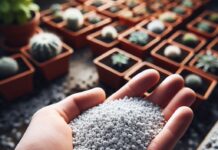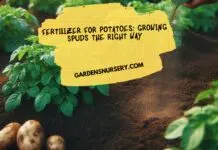How to Buy The Best Organic Fertilizers for Gardening
What Type Of Fertilizer Do I Need?
Choosing a garden fertilizer can be tricky for rookie growers, but it does not have to be a difficult decision. Keep reading to learn what to consider when choosing what kind of fertilizer you need to grow large, healthy plants in your garden.
Organic fertilizers are excellent for gardens; not only do they feed the soil to improve it for subsequent years, but users never have to worry about over-fertilizing to the point where the chemicals kill their plants. There are some disadvantages to using organic fertilizers, however.
Those who choose to fertilize organically will not see quick results because these fertilizers act more slowly than chemicals do. Organic fertilizers also may depend on the type of soil or the climate that they are being used in; in other words, gardeners may not be able to use the instructions on the packaging to determine how much fertilizer to apply.
Chemical fertilizers have some advantages that organic fertilizers lack, including “quick-fix” results for a dying garden, they are usually easier to find in average stores, and they cost less than their organic counterparts. One of the biggest disadvantages of using chemical fertilizers is that they add nothing to the soil to improve your garden for the years ahead.
Organic Fertilizers for Gardening
The recent controversy on using chemical or inorganic fertilizers and its harmful effects on the environment has brought about the organic movement in the agricultural sector. For environmental and health reasons, more and more farmers and home growers have turned to organic fertilizers as the solution. As a result, the organic fertilizer industry has experienced a boom in its profits.
People, from regular backyard growers to big-time farmers, are buying organic fertilizers for their gardens and farms. But with all the attention shifting to organic fertilizers, buying them has become a confusing task, especially since there are several factors involved: N-P-K, organic matter content, moisture content, etc. To the average home grower seed, all these numbers and percentages in an organic fertilizer bag tend to become perplexing. This article is aimed to help you, the home grower, make an informed decision before buying organic fertilizers.
How to Choose Fertilizers
There are many options for fertilizers, including non-organic options. Organic fertilizers are better than non-organic fertilizers because they are not made with petroleum products that will adversely affect the health of your soil in the long term. To choose the right organic fertilizer for your needs, there are a few considerations that you need to make.
1. Different Types of soil
First, what type of soil do you have? Is that clay, sand, or loam? Marl is considered the holy grail of soil types, but most of us have a combination of all three, with exceptional clay or sand. Sandy soils are excellent with drainage, almost too large, but have difficulty maintaining nutrients. Clay soils are very fertile but have drainage problems.
The fertilizer you use should take into account the type of soil you have so that your fertilizer is not dragged into sandy soil by the first rain. Or cause calcium deposits in clay soil due to lack of drainage. If you have a loafer, congratulations! You just need a basic fertilizer formulated for the type of plant life you have.
2. Are your Vegetable crops Need Nutrients
The second thing to consider is what your floor really lacks. The best way to determine it is to perform a basic test on the floor. They do not cost much and are usually made through their local horticulture extension, but it is possible to buy home tests. Once the soil analysis is done, your report will tell you the nutrient composition of your soil and you can match your fertilizer to what is missing.
3. Fertilizers Form
Fertilizers are in liquid or dry form. Dry fertilizers are slower to release and last longer. They are good when general maintenance of the plant is necessary and rebuild nutrients directly in the soil. Liquid fertilizers act faster and are better when your plant’s roots need a boost. For example, in late summer, when the heat and optimal water conditions weigh on your flowering plants or vegetable crop, an injection of liquid fertilizer may be the right choice to carry them throughout the season.
What to look for in An Organic Fertilizer
1. What does N-P-K mean?
There are three major nutrients that plants need in order to fast grow. These are Nitrogen (N), Phosphorus (P), and Potassium (K). Organic fertilizers tend to have low percentages of these three elements (although some organic fertilizer manufacturers have supplemented this by placing rich additional nutrients). So when buying organic fertilizers, it is important to take note of the N-P-K analysis first.
2. What Do The Numbers Mean?
For instance, a bag of organic fertilizer has an N-P-K analysis ratio of 5-2-2. This means that organic fertilizer has 5% Nitrogen, 2% Phosphorus, and 2% Potassium.
Organic fertilizers are labeled with a percent-rich nutrient concentration. These reports are known as the NPK ratio report, which represents nitrogen, phosphorus, and potassium. In a 6-12-0 formula ratio, for example, there is 6% nitrogen, 12% phosphorus, and 0% potassium. It’s also a good idea to consider other types of nutrients you may need. Fertilizers have all kinds of micronutrients and minerals that can replenish other missing pieces of your soil.
The second thing to consider when buying organic fertilizers is the ingredients stated on the label. If you find that the organic fertilizer bag contains ammonium, demonstrate, urea, nitrate, or phosphoric acid, don’t buy it. This means that it is not an organic fertilizer you are holding, but an inorganic fertilizer.
Organic fertilizers are valued for their organic matter content. Organic matters inorganic fertilizers are important in developing the soil structure and encouraging microbial activity. Also, organic matter inorganic fertilizers help improve the soil’s nutrient and water-holding capacity. Therefore, if you want your garden to be healthy, then look for organic matter content before buying an organic fertilizer.
Another important ingredient to look for inorganic fertilizers is the number of trace elements present in the bag. Plants need trace elements in organic fertilizers in order to sustain growth. Trace elements found in organic fertilizers are generally comprised of Calcium, Iron, Manganese, Copper, and Zinc.
It is also important to look into the raw materials used in making organic fertilizer. The richest source of trace elements among organic fertilizers is marine products, like seagrass and fish by-products. This type of organic fertilizer is practically a storehouse of trace elements and is also high in Nitrogen content ratio. Other types of organic fertilizers are bone meal and blood meal, which are excellent sources of calcium, protein, and soluble organic Nitrogen.
Read More: What are the Benefits of Organic Fertilizer?
Best 05 Organic Fertilizers – Reviews
1. Jobe’s Organics Vegetable & Tomato Fertilizer Spikes
Jobe Organic Vegetables and Tomatoes Fertilisers Jobe have made fertilizing super easy by putting it in the form of tips to be buried in the soil near the root system of the plant. There is no mixture, they are easy to carry and store, and easy to apply.
This particular formula contains an NPK ratio of 2-7-4 in combination, with nitrogen, phosphate, potassium, calcium, magnesium, and sulfur. Peaks are driven to the soil near the root system so that the plant can begin to absorb nutrients as soon as possible, but you do not have the inconvenience of dilution as you do with liquid fertilizers.
A problem with peaks that are often reported is that animals like to dig them up. If you have dogs or other animals, put a kind of barrier until the beak dissolves enough for your plants to enjoy.
Pros
- Full Active Ingredients Easy to use and store
Cons
- applying fertilizer It becomes expensive for large gardens
- All natural, environmentally friendly
- OMRI listed for organic gardening
- No mixing or measuring
- Continuously feeds at the roots
- Low odor formula
2. Humboldts Secret Golden Tree: Best Plant Food for Plants & Trees
Best Humboldts Secret Golden Tree Plant & Tree Food – The best food for plants & trees is a professional quality fertilizer that works on a variety of plant types. Activates enzymes in the root system that promote growth and production, as well as the improvement of photosynthesis.
It also provides nutrients for vegetables, flowers, and even roses. It is easy to store. It comes in a 2-ounce bottle that makes 28 gallons of fertilizer, although larger sizes are available if you do serious fertilization.
Just follow the instructions on the label with the following precautions. With this product, it is good to do a small test with smaller quantities than recommended to see how your plants react.
There may be some problems with burning fertilizers when adding to full power for the first time, but most people should see positive results with the recommended amounts.
Pros
- Very powerful,
- Professional fertilizer concentrate, so it is easy to store Very affordable Works ideal for almost all types of plants
Cons
- The fertilizer can cause fertilizer burns, test first The container is of low quality
- FOR ANY PLANT: Our Golden Tree formula is an all-in-one additive for any plant, tree, flower or bush. When used with a well-balanced fertilizer, Golden Tree helps improve soil/foliar nutrient conditions for better crop yields. In addition to improving overall plant nutrition, Golden Tree supports conditions for better plant establishment, nutrient uptake and abiotic stress tolerance.
- GROW METHOD COMPATIBLE: No matter what grow method you’re using, Humboldts Secret Golden Tree solution will help feed growing plants. It’s designed to be compatible in all mediums - hydroponics, aeroponics, coco, DWC, soil, and every other type of growing method.
- ESSENTIAL NUTRIENTS: Golden Tree can help provide essential nutrients to your garden that it isn't getting now. Our formula contains a mixture of kelp, carbs and minerals. It can be used in conjunction with other additives and fertilizers or as the only additive.
- SMALL & STRONG: Our 2-ounce solution makes up to 55 gallons of an easy-to-use additive solution to feed your plants. This is a professional-quality fertilizer that can transform any home and garden and give anyone a green thumb!
3. Neptune’s Harvest Organic Hydroliszed Fish & Sevest Algae Fertilizer
Neptune’s Harvest combines fish and algae to give you the best of both products in an easy-to-use formula. Fish emulsion and algae produce natural sugars in plant leaves, helping them strengthen even in dry or excessive heat conditions. Flowers, fruits, and foliage are stronger and more productive, and fruits have a longer shelf life. The product is easy to use.
Just dilute in water as the instructions say and use it to water the plant’s roots, or use it as a foliar spray.
Pros
- The liquid is easier to apply than dry fertilizers
- It works best with flowers (it is also ideal for some vegetable crop)
Cons
- fish algae are hit and lost by different plants
- If it is incorrectly mixed or stored, this fertilizer can get smells dogs and cats love the smell
- Grow a beautiful vegetable garden
- Flowers and foliage will be stronger and more colorful
- Blooms will be more plentiful, fragrant and longer lasting
- Easy to mix and apply by hand, sprayer, or drip line
4. Fox Farm FX14049 Liquid Nutrient Trio Soil Formula
Fox Farm is well known in gardening forums and although inexpensive, produces results. This particular fertilizer is actually a three-part fertilizer for each stage of the plant’s life. The first bottle is Grow Big Hydro to support abundant foliage growth.
The second bottle is Tiger Bloom and is for the first signs of flowers and flowers. The third bottle, Big Bloom, can be used throughout the growing cycle to continuously heal root systems and promote the nutrient cycle. It is also ideal for last-season flowers and vegetables.
Pros
Easy to use 3-in-1 solution for different stages of growth It comes with feed schedule and guides Cons initial price is high. There are no options for choosing different sizes
Cons
- In addition to the price is that it can increase the pH of the soil.
- Regular soil analyses will help you maintain pH equilibrium.
- It is also available in the same trio of hydroponic producers; just look for the correct formulation on the label.
- A 3-pack of favorite liquid fertilizers from FoxFarm
- Get the right juice for the right use
- Start with Grow Big Hydro for abundant green growth
- Switch to Tiger Bloom at the first sign of bud set or flowering
- Use Big Bloom throughout all growing cycles to heal root systems and increase nutrient cycling
5- SEA-90 Organic Fertilizer for Hydroponics
SEA-90 is a versatile fertilizer that can be used even for hydroponics. It is harvested from mineral deposits in the ocean and is free of odor. It is soluble in water, so it works very well in a sprayer.
organic fertilizers SEA-90 is also classified as an additive for livestock due to natural minerals, so if you do both gardening and breeding, this product will take care of both at once. One caveat of this product is that it tends to increase the acidity of the soil, so if your soil tends to be on the alkaline side, it should not be too much of a problem.
Rapid soil analysis at home should help regulate the pH levels of plants that have a harder period under acidic conditions, although many common shrubs, trees, and flowers prefer acidic pH levels.
Pros
- without odor,
- It can also be used as a mineral additive for cattle with OMRI
Cons
- Certification can increase the pH of the soil Only OK
Growing Healthy Vegetables and Herbs with Compost Homemade Organic Fertilizers
If you plan to plant a garden at home, you can easily grow one just like professional farmers, but without the chemicals.
There’s nothing like the taste of homegrown tomatoes. Regular grocery store produce sections have red globe-shaped vegetables that look like tomatoes, but they taste nothing like the real thing growing in your own garden. The same truth applies to most vegetables in grocery stores that are shipped from faraway places or other countries. Unless you make regular trips to a farmer’s market or roadside vegetable stand, the only way to get that home-grown taste is to plant your own garden at home.
Many home gardeners choose to grow their own vegetables not only because they taste better, but also because they can control whether or not they are exposed to chemicals, fertilizers, or other toxic materials intended to make them grow faster, bigger, pest-free, or sturdier. Those substances may make the vegetable crop look better and last longer, but they can dramatically affect the nutritional value and definitely the taste.
Fertilizer is one of the most heinous offenders when it comes to making vegetables toxic. Everyone knows that when you buy vegetables from the grocery store you must wash them thoroughly before eating them, but even then there is only so much you can wash off because fertilizers are often applied from overhead by spraying. Instead of chemical fertilizers, it’s easy to find natural alternatives that work just as well and are much healthier:
Coffee Grounds and Ashes compost:
Manure:
Seaweed:
Green Manure:
In the fall, after clearing out vegetables or flowers from your garden, you can sow a green manure crop such as winter rye or vetch. Plants such as these flourish in cool weather, thereby protecting your garden bed from weeds and erosion. Three or four weeks before planting in the spring, simply turn the winter crop over by digging it into the soil. As the plants decompose, they become fertilizer for the next crop by adding humus to the soil.
If you are careful to mix compost and home-grown organic fertilizers, you will be able to customize your raised garden beds specifically for the vegetables and flowers you’re fast-growing. One of the best things you can do to ensure that your soil is exactly what you want it to be, you can have it tested.
Soil tests are available from a state agricultural university if there is one in your area, or you can get one from a local Cooperative Extension office. The results of a soil test will tell you exactly what you need to do to fertilize your soil and add whatever trace elements are necessary. Knowing how your soil will perform for you will help you to give your plants exactly what they need to thrive and produce. There is nothing like home-grown vegetables, so taking the time to ensure that they have ideal conditions for fast-growing happily will end up making you happy.
Where to Buy Organic Fertilizers
Organic fertilizers are available anywhere from your local garden center to even online sources like Amazon Store. Here are three examples of online stores where you can purchase organic fertilizers at reasonable prices. Of course, these stores aren’t the be-all and end-all of organic fertilizers.















